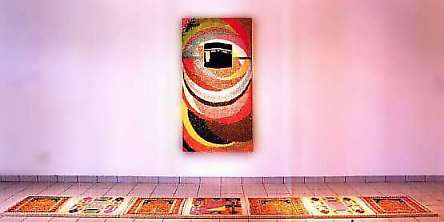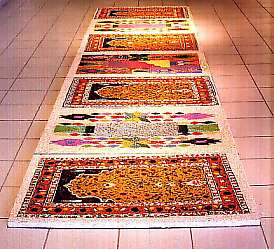Rookeya Gardee

Artists
- Wim Botha
- Bob Cnoops
- Hugo Crosthwaite (Mexico)
- James de Villiers
- Sasha Fabris
- Gordon Froud
Rookeya Gardee

- David Hlynsky (Canada)
- Ashley Johnson
- Nkosinathi Khanyile
- Ania Krajewski
- Michael Matthews
- Nhlanhla Mbatha
- Rankadi Mosako
- Margi Scharff (USA)
- Diane Victor
DASART shows
Transmigrations - the show
Fokofo
Dasart Archives
Work Title : Musallah
"Transmigration" is a term particularly well suited to the Indian community of South Africa. The community has managed to preserve their religion, languages and cultural heritage, while at the same time, adapting to overpowering Western influences.
"Ritual", used in the form of prayer, is the single, and most powerful strength that the community depends on. The spirit and essence of the Indian people come from the disciplinary, repetitious ritual, or prayer, called 'salah'. Migration from one country to another means change of addresses, a change of physical location, politics, economics, traditions and culture. While this is a challenge in itself, the most difficult challenge is the altered state of being within oneself.
 The obsession with the physical body, worldly
material gain and the insistence on self gratification is a process which is slowed down
or even eradicated by the five-time-a-day salah, or ritual. To be able to achieve this
altered state of consciousness, the Muslim engages in prayer, meditation and submits to
the Will of Allah completely. This prayer is performed on a special mat or carpet and
everyone over the age of twelve possesses one. This mat is called 'Musallah'. The ritual
performed on it is a series of strictly coded verses to be recited while performing
certain movements. Some of these are standing upright, bowing down, sitting and
prostrating, all facing the Almighty Creator. The prayer is directed to the Kaaba in
Mecca, which Abraham and his ancestors before him, built. For the Muslim, this is the
house of God on earth. But while prayer and ritual work hand in hand in Islamic theosophy,
so does ritual work hand in hand with domesticity.
The obsession with the physical body, worldly
material gain and the insistence on self gratification is a process which is slowed down
or even eradicated by the five-time-a-day salah, or ritual. To be able to achieve this
altered state of consciousness, the Muslim engages in prayer, meditation and submits to
the Will of Allah completely. This prayer is performed on a special mat or carpet and
everyone over the age of twelve possesses one. This mat is called 'Musallah'. The ritual
performed on it is a series of strictly coded verses to be recited while performing
certain movements. Some of these are standing upright, bowing down, sitting and
prostrating, all facing the Almighty Creator. The prayer is directed to the Kaaba in
Mecca, which Abraham and his ancestors before him, built. For the Muslim, this is the
house of God on earth. But while prayer and ritual work hand in hand in Islamic theosophy,
so does ritual work hand in hand with domesticity.
"Item" is found in the musallah, or prayer carpet. But I also have discovered other ' items' of ritual in my home. In my daily chore of cleaning lentils, rice, grains and spices, doing embroidery and knitting, I observe the act of ritual. Not too unlike traditional African beading, lentils, for example look very much like beads, except that they are natural with exciting colours and textures and aromas. To transform the somewhat monotonous domesticity into some more creative and thought provoking act, I use embroidery (a ritual), lentils, medicine - tablets and pills, and for colour, onion juice, beetroot juice, henna, saffron, turmeric etc. Thus my medium, the musallah and household paraphernalia becomes my ritual of not only prayer, domesticity, but also art making.
Rookeya Gardee
Top